Compliance Checking on Topological Spatial Relationships of Building Elements Based on Building Information Models and Ontology
Abstract
1. Introduction
2. Literature Review
2.1. Compliance Checking
2.2. BIM-Based Building Spatial Relationship Acquisition
2.3. Knowledge Gaps
3. Methodology
3.1. Quantitative Translation
3.1.1. Extraction and Classification of Building Topological Spatial Relationships
3.1.2. Quantitative Expressions of Topological Spatial Relationships
Quantitative Expression of Adjacency Relation
Quantitative Expression of Connection Relation
Quantitative Expression of Inclusion Relation
3.1.3. Checking Rules’ Establishment
3.2. Data Extraction
3.3. Ontology Development and Instantiation
3.4. Rule-Based Checking
4. Results and Discussion
5. Case Study
6. Conclusions
Author Contributions
Funding
Institutional Review Board Statement
Informed Consent Statement
Data Availability Statement
Acknowledgments
Conflicts of Interest
References
- Nawari, N.O. Building Information Modeling: Automated Code Checking and Compliance Processes; CRC Press: Boca Raton, FL, USA, 2018; pp. 1–17. [Google Scholar]
- Xu, X.; Cai, H. Ontology and rule-based natural language processing approach for interpreting textual regulations on underground utility infrastructure. Adv. Eng. Inform. 2021, 48, 101288. [Google Scholar] [CrossRef]
- Tang, P.; David, G.; Mounir, E.A. Using Building Information Modeling to Transform the Building Codes Compliance Process. In Proceedings of the Construction Research Congress 2020: Computer Applications, Washington, WA, USA, 8–10 March 2020. [Google Scholar]
- IFC4 Documentation. Available online: https://standards.buildingsmart.org/IFC/RELEASE/IFC4/ADD2/HTML/ (accessed on 5 July 2023).
- Lin, J.; Guo, J. Automated BIM-based compliance review. J. Tsinghua Univ. Nat. Sci. Ed. 2020, 60, 873–879. [Google Scholar]
- Andre, B.; Ernst, R. Topological operators in a 3d spatial query language for building information models. In Proceedings of the 12th International Conference on Computing in Civil and Building Engineering (ICCCBE), Munich, Germany, 20 June 2008. [Google Scholar]
- Andre, B. Topological analysis of 3d building models using a spatial query language. Adv. Eng. Inform. 2009, 23, 370–385. [Google Scholar]
- Simon, D.; André, B. Processing of Topological BIM Queries using Boundary Representation Based Methods. Adv. Eng. Inform. 2014, 28, 272–286. [Google Scholar]
- Xue, X.; Zhang, J. Regulatory information transformation ruleset expansion to support automated building code compliance checking. Autom. Constr. 2022, 138, 104230. [Google Scholar] [CrossRef]
- Malsane, S.; Matthews, J.; Lockley, S.; Love, P.E.; Greenwood, D. Development of an object model for automated compliance checking. Autom. Constr. 2015, 49, 51–58. [Google Scholar] [CrossRef]
- Murat, A. Building Information Modeling Based Automated Building Regulation Compliance Checking. Intell. Autom. Soft Comput. 2021, 28, 11–25. [Google Scholar]
- Eastman, C.; Lee, J.M.; Jeong, Y.S.; Lee, J.K. Automatic rule-based checking of building designs. Autom. Constr. 2009, 18, 1011–1033. [Google Scholar] [CrossRef]
- Aimi, S.I.; Kherun, N.A.; Noorminshah, A.I. A review on BIM-based automated code compliance checking system. In Proceedings of the International Conference on Research and Innovation in Information Systems (ICRIIS), Langkawi, Malaysia, 16–17 July 2017. [Google Scholar]
- Zhang, J.; Nora, M. El-Gohary.Integrating semantic NLP and logic reasoning into a unified system for fullyautomated code checking. Autom. Constr. 2017, 73, 45–57. [Google Scholar] [CrossRef]
- Dareen, S.; El-Gohary, N.M. Semantic modeling for automated compliance checking. In Proceedings of the International Workshop on Computing in Civil Engineering, Miami, FL, USA, 19–22 June 2011. [Google Scholar]
- Li, S.; Cai, H.; Vineet, K. Integrating natural language processing and spatial reasoning for utility compliance checking. J. Constr. Eng. Manag. 2016, 142, 04016074. [Google Scholar] [CrossRef]
- Zheng, Z.; Zhou, Y.C.; Lu, X.Z.; Lin, J.R. Knowledge-informed semantic alignment andrule interpretation for automated compliancechecking. Autom. Constr. 2022, 142, 104524. [Google Scholar] [CrossRef]
- Zhou, Y.C.; Zheng, Z.; Lin, J.R.; Lu, X.Z. Integrating NLP and context-free grammar forcomplex rule interpretation towards automatedcompliance checking. Comput. Ind. 2022, 142, 103746. [Google Scholar] [CrossRef]
- Jiang, L.; Shi, J.; Wang, C. Multi-ontology fusion and rule development to facilitate automated code compliance checking using BIM and rule-based reasoning. Adv. Eng. Inform. 2022, 51, 101449. [Google Scholar] [CrossRef]
- Virginie, F.; Thomas, P.; Ludovic, L.S. SWRL as a Rule Language for Ontology-Based Models in Power Plant Design. In Proceedings of the 9th IFIP WG 5.1 International Conference on Product Lifecycle Management (PLM), University Quebec, Ecole Technologie Superieure, Montreal, QC, Canada, 9–11 July 2012. [Google Scholar]
- Johannes, D.; Robert, A. Regulatory knowledge representation for automated compliance audit of BIM-based models. In Proceedings of the 30th CIB W78 International Conference, Beijing, China, 9–12 October 2013. [Google Scholar]
- Wawan, S.; Charles, M.E. A knowledge representation approach in BIM rule requirement analysis using the conceptual graph. J. Inf. Technol. Constr. 2016, 21, 370–401. [Google Scholar]
- Dimyadi, J.; Clifton, C.; Spearpoint, M.; Amor, R. Computerizing regulatory knowledge for building engineering design. J. Comput. Civ. Eng. 2016, 30, C4016001. [Google Scholar] [CrossRef]
- Ilal, S.M.; Günaydın, H.M. Computer representation of building codes for automated compliance checking. Autom. Constr. 2017, 82, 43–58. [Google Scholar] [CrossRef]
- Jiang, H.; Wu, Z. Research on cloud storage and retrieval method of BIM spatial relationship data. J. Graph. 2018, 39, 835–842. [Google Scholar]
- Zhang, J.; He, L.; Lin, J.; Cheng, X.; Zhang, Y. BIM-based extraction and application of building space and equipment topology information. J. Tsinghua Univ. Nat. Sci. Ed. 2018, 58, 587–592. [Google Scholar]
- André, B.; Ernst, R. Specification and implementation of directional operators in a 3d spatial query language for building information models. Adv. Eng. Inform. 2009, 23, 32–44. [Google Scholar]
- André, B.; Ernst, R. Towards a 3D Spatial Query Language for Building Information Models. Comput. Sci. 2009, 23, 370–385. [Google Scholar]
- Zhou, Y.; Hu, Z.; Lin, J. A Review on 3D Spatial Data Analytics for Building Information Models. Arch. Comput. Methods Eng. 2020, 27, 1463–1469. [Google Scholar] [CrossRef]
- den Bergen, G.V. Efficient collision detection of complex deformable models using aabb trees. J. Graph. Tools 2012, 6, 1–13. [Google Scholar] [CrossRef]
- Khalili, A.; Chua, D.K. IFC-Based Graph Data Model for Topological Queries on Building Elements. J. Comput. Civ. Eng. 2013, 29, 04014046. [Google Scholar] [CrossRef]
- Wawan, S.; Charles, E.; Lee, Y.C. Multiple representation approach to achieve high-performance spatialqueries of 3D BIM data using a relational database. Autom. Constr. 2017, 81, 369–388. [Google Scholar]
- Solihin, W.; Eastman, C.; Lee, Y.C.; Yang, D.H. A simplified relational database schema for transformation of BIM data intoa query-efficient and spatially enabled database. Autom. Constr. 2017, 84, 367–383. [Google Scholar] [CrossRef]
- Nguyen, T.H. Spatial Information: Classifification and Applications in Building Design. Comput. -Aided Civ. Infrastruct. Eng. 2002, 17, 246–255. [Google Scholar] [CrossRef]
- Industrial Standard Library. Available online: https://www.gongbiaoku.com/ (accessed on 5 July 2023).
- GB50096-2011; Code for Residential Design. China Standard Publishing House: Beijing, China, 2011.
- JGJ/T67-2019; Code for Design of Office Buildings. China Architecture Publishing & Media Co: Beijing, China, 2019.
- GB50011-2010; Code for Seismic Design of Buildings. China Standard Publishing House: Beijing, China, 2010.
- GB50016-2014; Code for Fire Prevention of Building Design. China Standard Publishing House: Beijing, China, 2014.
- Nguyen, T.H.; Oloufa, A.A.; Khaled, N. Algorithms for automated deduction of topological information. Autom. Constr. 2005, 14, 59–70. [Google Scholar] [CrossRef]
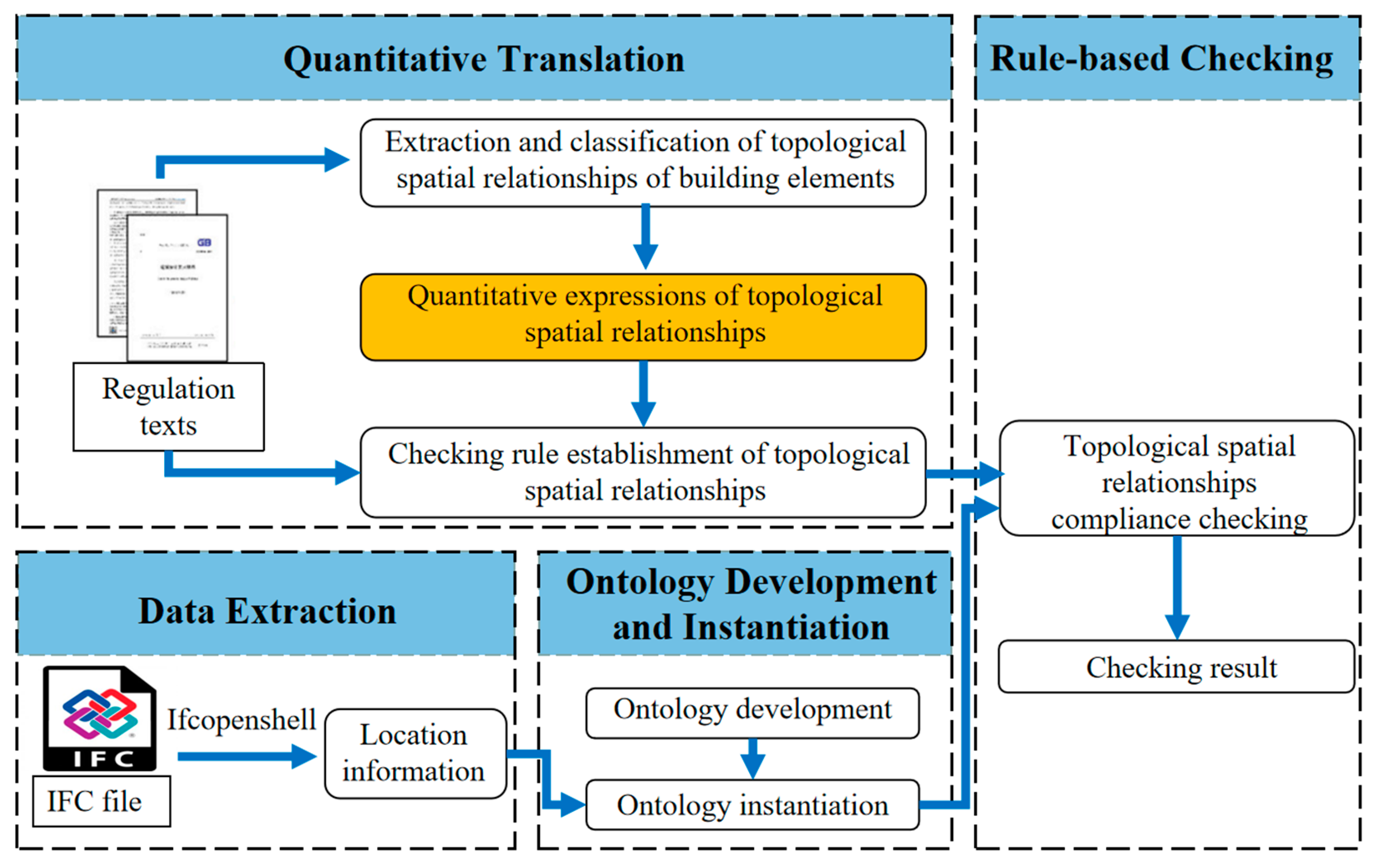
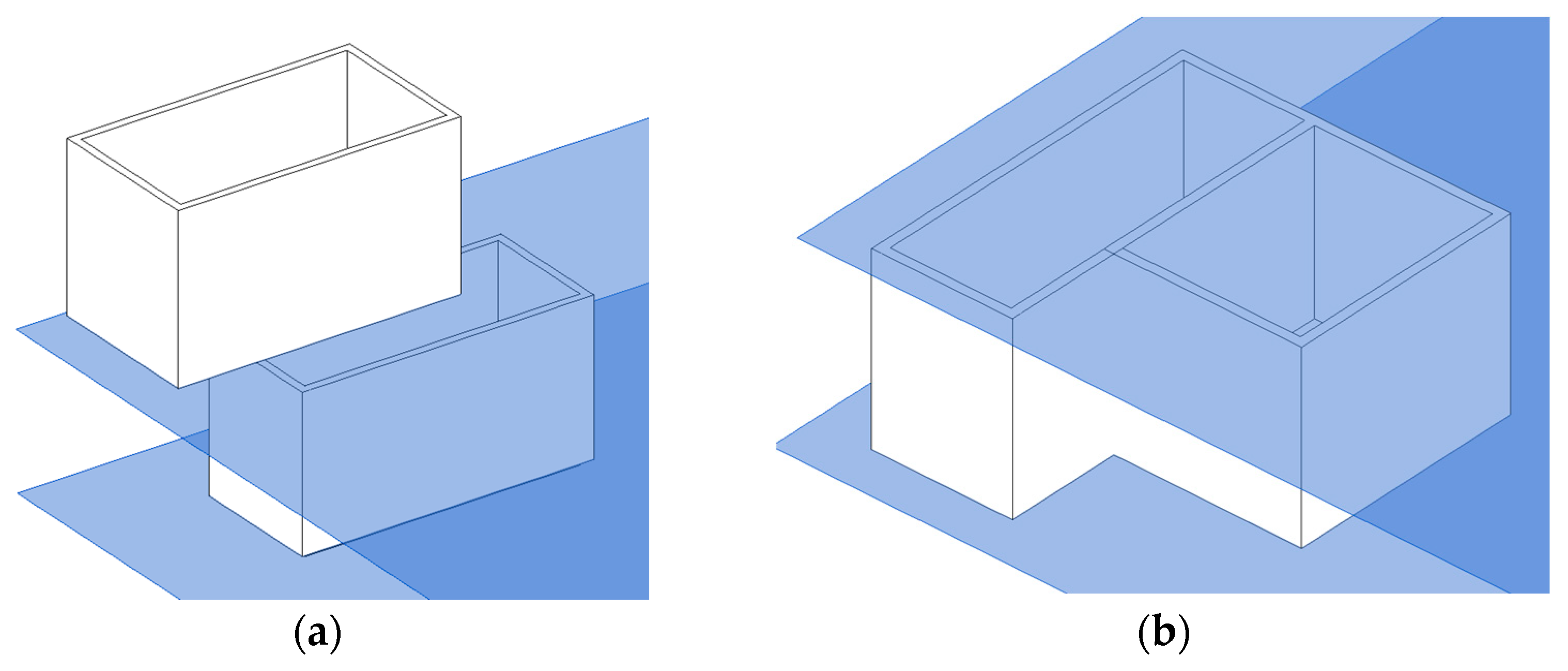
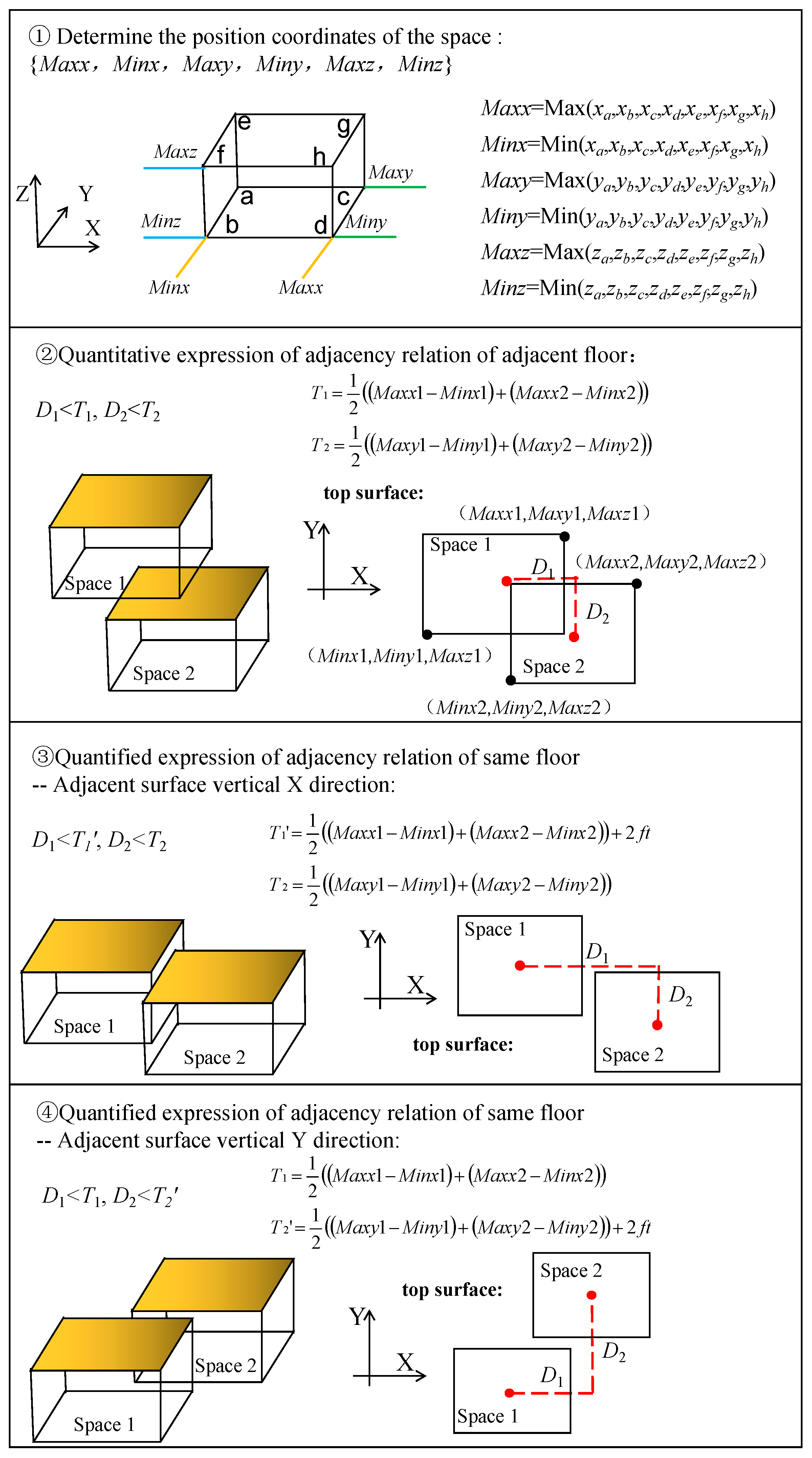
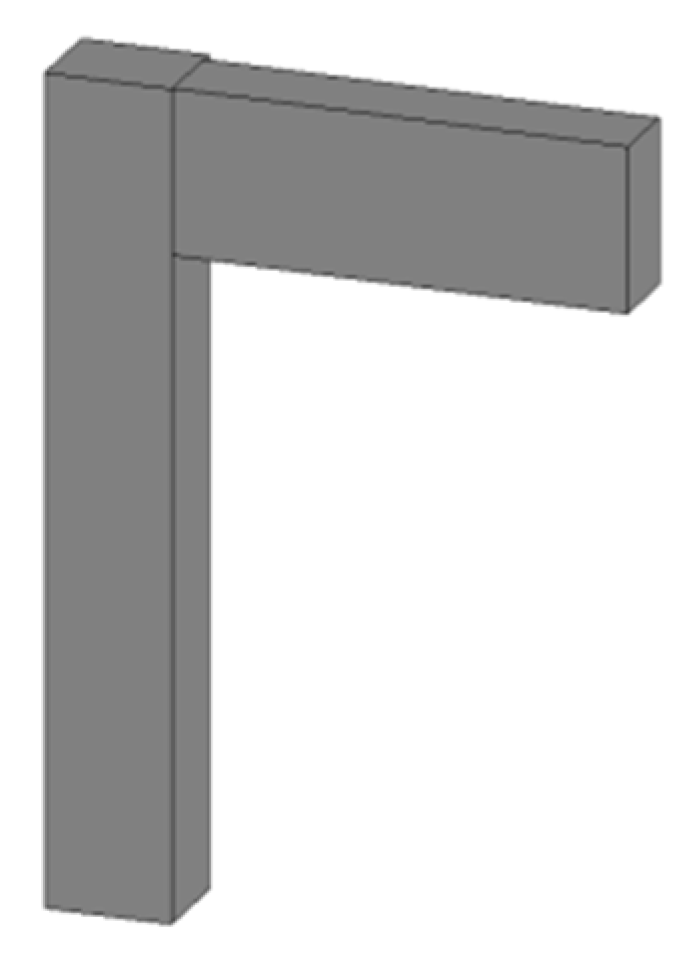
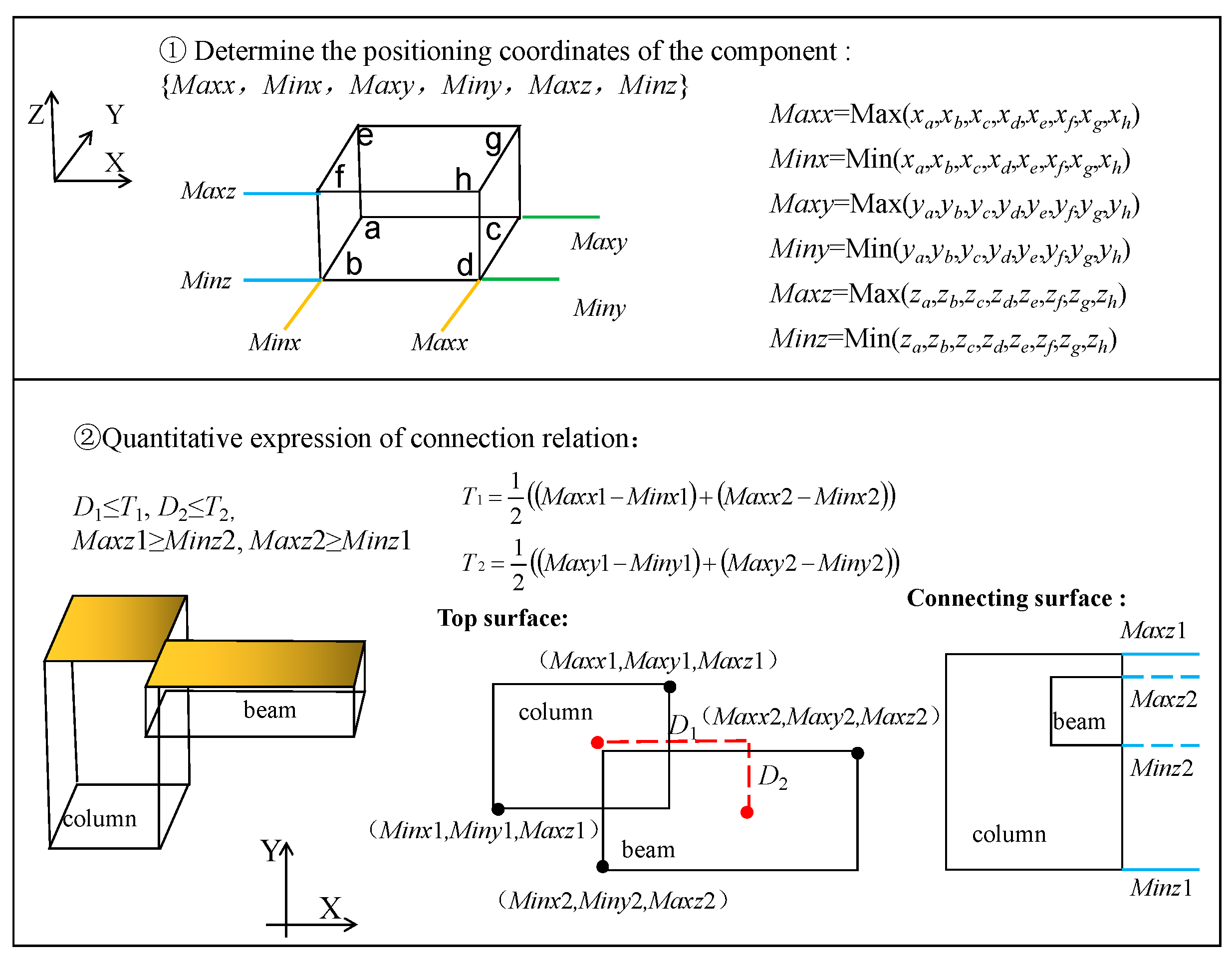
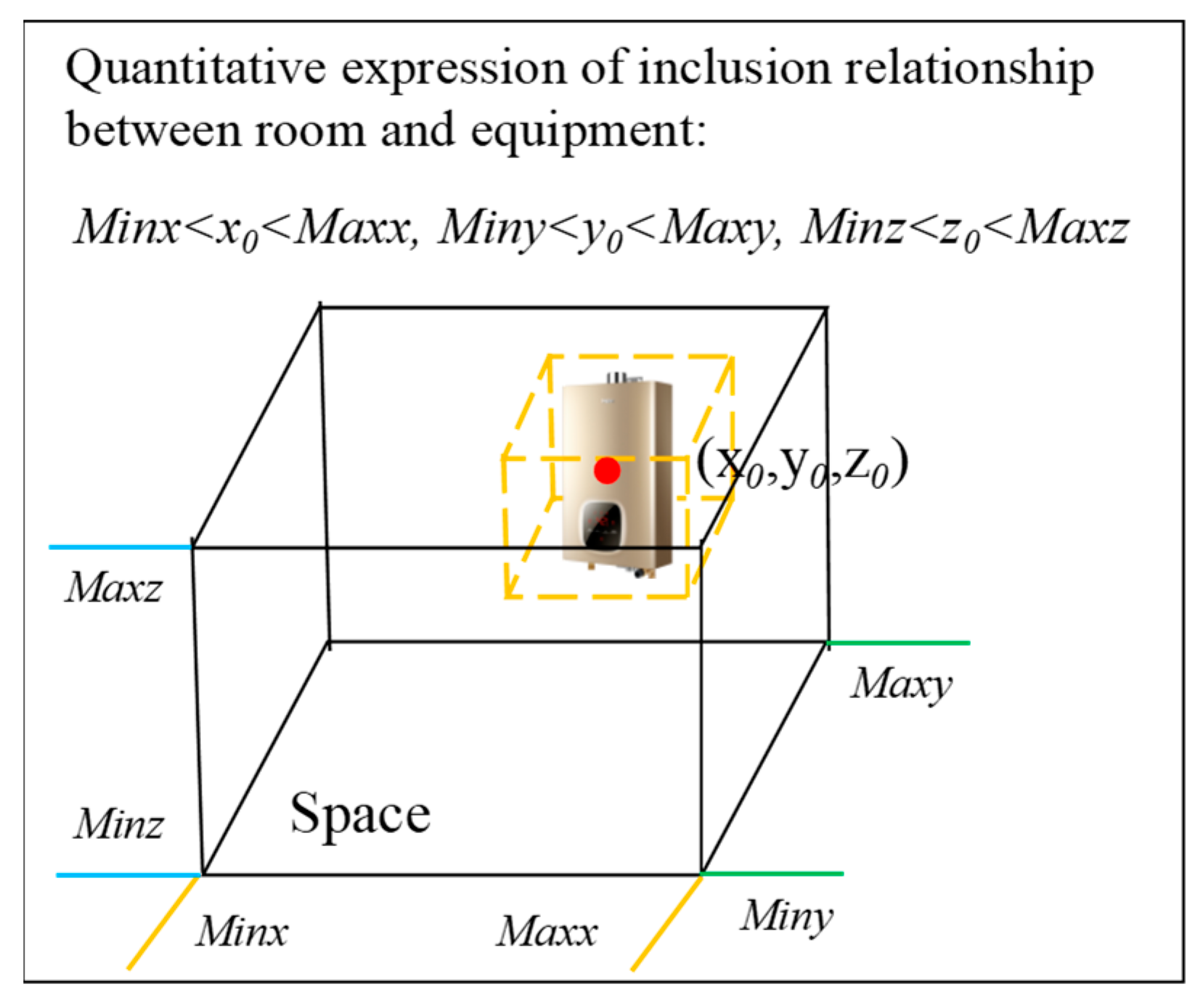
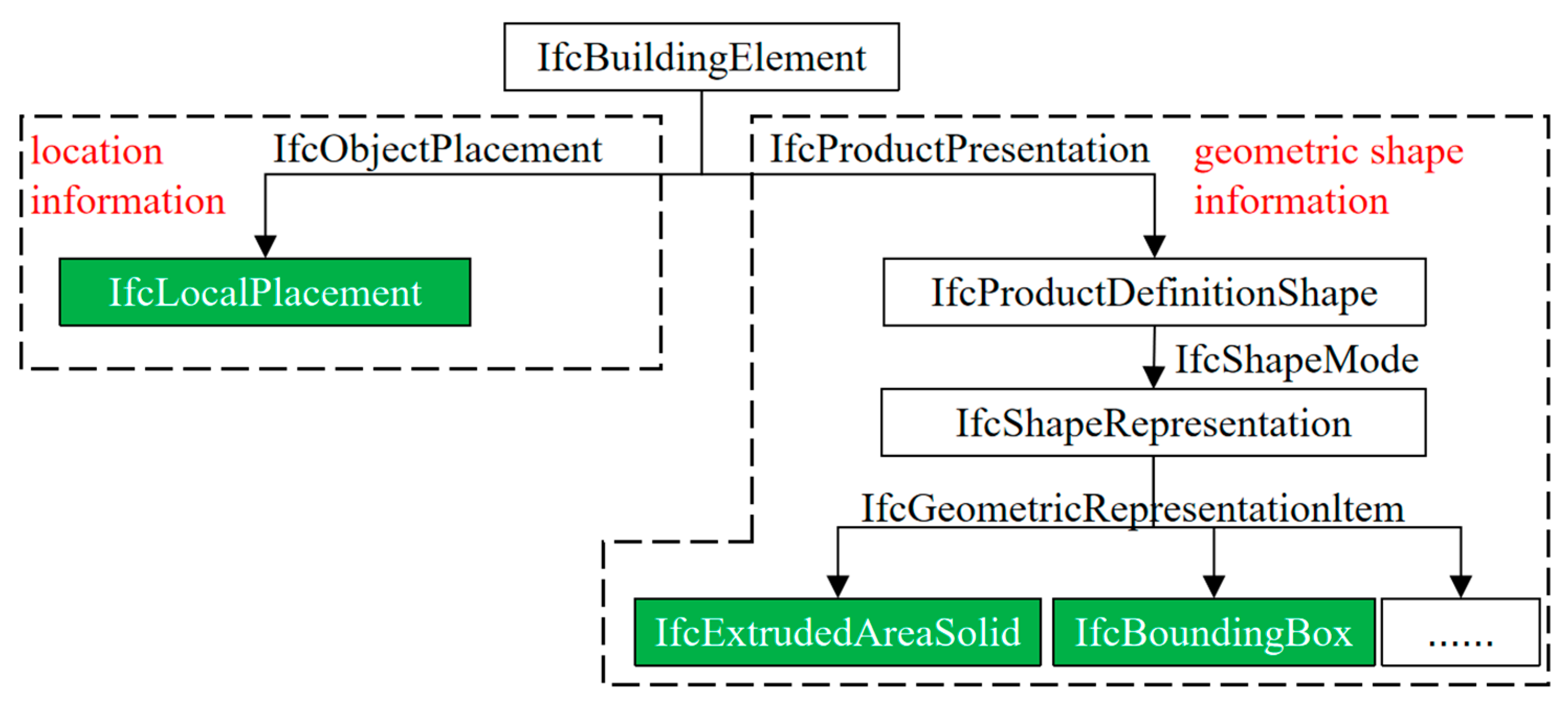
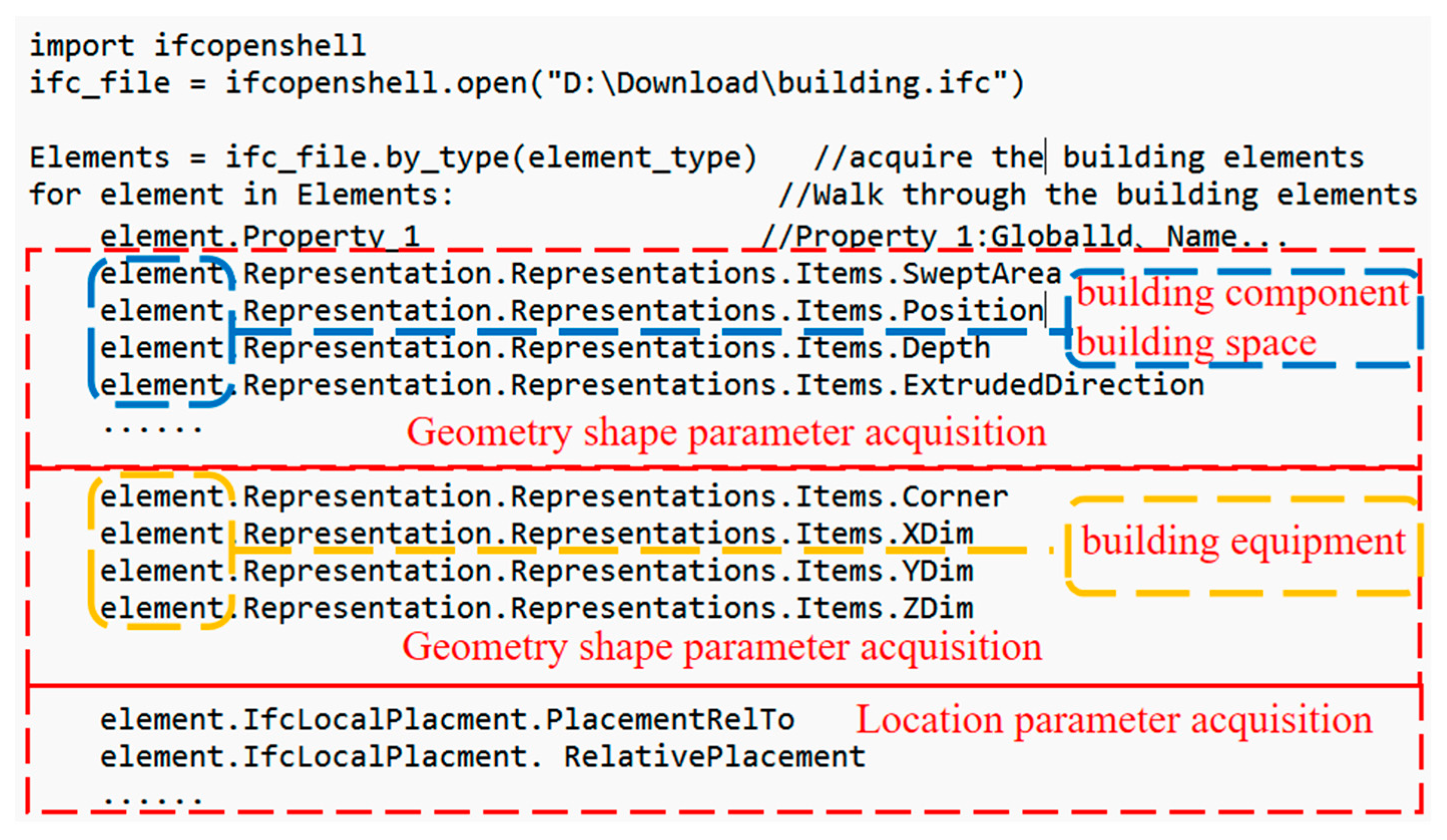

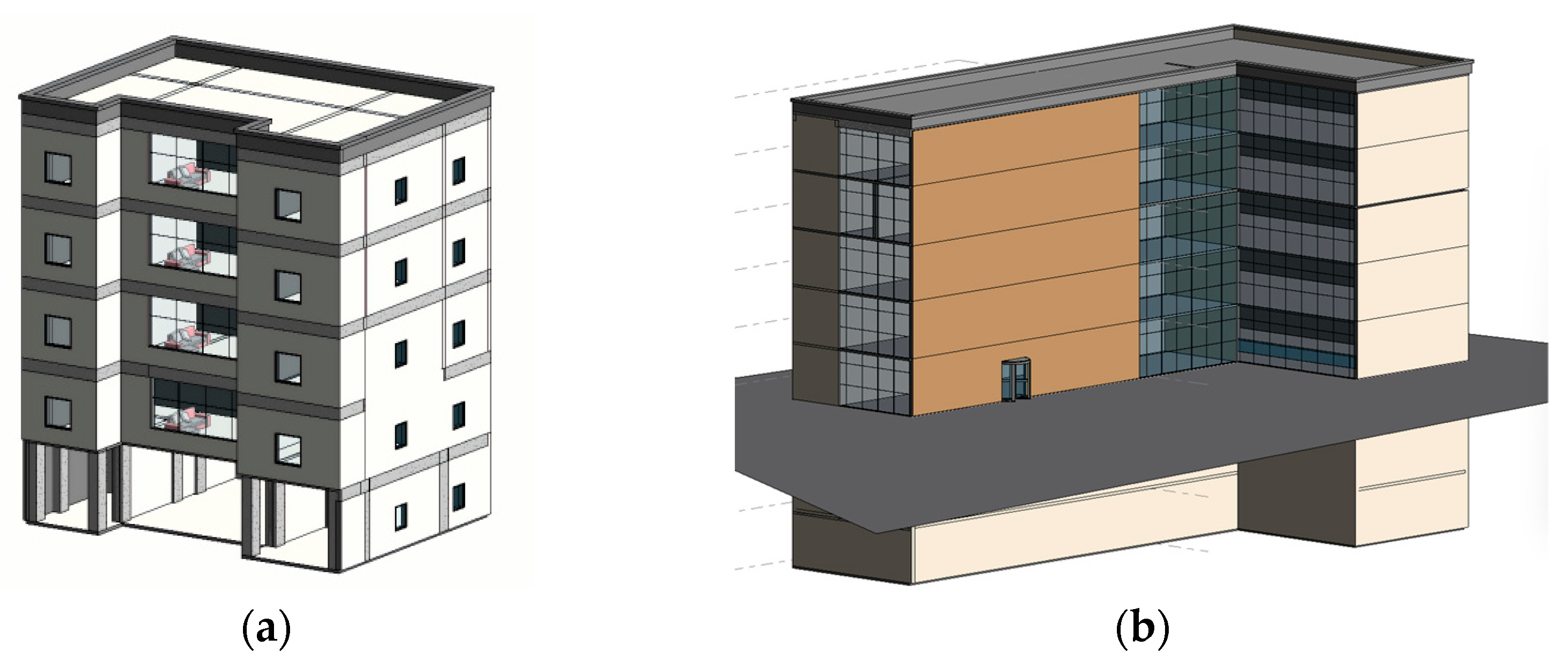
| Regulation Texts of Building Topological Spatial Relations | Building Topological Spatial Relations in Regulation Texts | Category of Building Topological Spatial Relations |
|---|---|---|
| GB50096-2011 regulation for Residential Design [36] 5.4.4: “The toilet shall not be placed directly on the upper floor of the bedroom, living room (hall), kitchen, and dining room of the lower floor occupant”. | upper floor lower floor | adjacency of adjacent floor |
| JGJ/T67-2019 regulation for Design of Office Buildings [37] 4.5.2: “The equipment room that generates noise or vibration should not be adjacent to office buildings and meeting rooms”. | adjacent to | adjacency of same floor |
| GB50011-2010 regulation for Seismic Design of Buildings [38] 13.3.4: “For masonry filled walls in reinforced concrete structures, when the wall height exceeds 4 m, reinforced concrete horizontal beams connected with columns and through the whole length of the wall should be installed at the half-height of the wall”. | connected with | connection |
| GB50096-2011 regulation for Residential Design [36] 8.4.3: “ It is strictly prohibited to install direct exhaust type, semi-sealed gas water heater and other heating equipment that accumulates harmful gas in the used space of the bathroom”. | install in | inclusion between space and equipment |
| GB50016-2014 regulation for Fire Prevention of Building Design [39] 5.4.3: “ Business Hall and exhibition hall shall not be set in the underground three floors or below”. | be set in | inclusion between floor and space |
| GB50016-2014 regulation for Fire Prevention in Building Design [39] 6.1.5: “Doors, Windows, and holes shall not be opened on the firewall”. | be opened on | inclusion between component and component |
| The Basic Expression Form | SPARQL Rule |
|---|---|
| (building space 1) (model words) (spatial relation) (building space 2) | SELECT ?a ?b WHERE { ?a rdf:type ont:(building space 1). ?b rdf:type ont:(building space 2). ?a ont:floor ?a floor. ?b ont:floor ?b floor. ?a floor ont:(upper floor) ?b floor. filter (D1 < T1 && D2 < T2)} |
| Attribute Name | Domain | Format |
|---|---|---|
| ID | building component, building equipment, building space | string |
| minx | building component, building space | int |
| maxx | building component, building space | int |
| miny | building component, building space | int |
| maxy | building component, building space | int |
| minz | building component, building space | int |
| maxz | building component, building space | int |
| x0 | building equipment | int |
| y0 | building equipment | int |
| z0 | building equipment | int |
| … |
| a | b | a Floor | b Floor | ID1 | ID2 |
|---|---|---|---|---|---|
| Bedroom 1 | Toilet 1 | first floor | second floor | 24 | 25 |
| Building Topological Spatial Relationships | Quantitative Expressions | |
|---|---|---|
| adjacency | adjacency of adjacent floor | D1 < T1, D2 < T2 |
| adjacency of same floor | When adjacent surface vertical X direction: D1 < T1′, D2 < T2 When adjacent surface vertical Y direction: D1 < T1, D2 < T2′ | |
| connection | D1 ≤ T1, D2 ≤ T2, Maxz1 ≥ Minz2, Maxz2 ≥ Minz1 | |
| inclusion between Space and equipment | Minx < x0 < Maxx, Miny < y0 < Maxy, Minz < z0 < Maxz | |
| Regulation Texts | Checking Rules | Design Modification Scheme |
|---|---|---|
| GB50096-2011 Regulation for Residential Design 5.4.4: “The toilet shall not be placed directly on the upper floor of the bedroom, living room (hall), kitchen, and dining room of the lower floor occupant”. | Q1: | Set the toilet above the bedroom: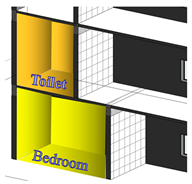 |
| SELECT ?a ?b ?ID1 ?ID2 ?a floor ?b floor WHERE {?a rdf:type ont: bedroom/living room (hall)/kitchen /dining room. ?b rdf:type ont:toilet. ?a ont:ID ?ID1. ?b ont:ID ?ID2. ?a ont:floor ?a floor. ?b ont:floor ?b floor. ?a floor ont: (upper floor) ?b floor. ?a ont:minx ?minx1. ?b ont:minx ?minx2. ?a ont:miny ?miny1. ?b ont:miny ?miny2. ?a ont:maxx ?maxx1. ?b ont:maxx ?maxx2. ?a ont:maxy ?maxy1. ?b ont:maxy ?maxy2. filter (D1 < T1 && D2 < T2)} | ||
| GB50011-2010 Regulation for Seismic Design of Buildings 13.3.4: “For masonry filled walls in reinforced concrete structures, when the wall height exceeds 4 m, reinforced concrete horizontal beams connected with columns and through the whole length of the wall should be installed at the half-height of the wall”. | Q2.1: | Adjust the height of the two walls to 8000 and only one set beam at the half height of the wall: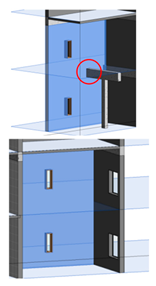 |
| SELECT ?a ?ID1 ?a floor WHERE { ?a rdf:type ont:masonry filled wall. ?a ont:ID ?ID1. ?a ont:height ?a height. ?a ont:floor ?a floor. Filter (?a height > 4)} | ||
| Q2.2: | ||
| SELECT ?a ?b ?ID1 ?ID2 ?a floor ?b floor WHERE {?a rdf:type ont:masonry filled wall. ?a ont:height ?a height. ?b rdf:type ont:beam. ?a ont:ID ?ID1. ?b ont:ID ?ID2. ?a ont:floor ?a floor. ?b ont:floor ?b floor. ?a ont:minx ?minx1. ?b ont:minx ?minx2. ?a ont:maxx ?maxx1. ?b ont:maxx ?maxx2. ?a ont:miny ?miny1. ?b ont:miny ?miny2. ?a ont:maxy ?maxy1. ?b ont:maxy ?maxy2. ?a ont:minz ?minz1. ?b ont:minz ?minz2. ?a ont:maxz ?maxz1. ?b ont:maxz ?maxz2. Filter (?a height > 4) Filter (D1 ≤ T1&&D2 ≤ T2) Filter ((?minz1 + ?maxz1) * 1/3 < (?minz2 + ?maxz2) * 1/2 && (?minz2 + ?maxz2) * 1/2 < (?minz1 + ?maxz1) * 2/3)} | ||
| GB50096-2011 Regulation for Residential Design 8.4.3: ”It is strictly prohibited to install direct exhaust type, semi-sealed gas water heater and other heating equipment that accumulates harmful gas in the used space of the bathroom”. | Q3: | Set gas water heater in the bathroom: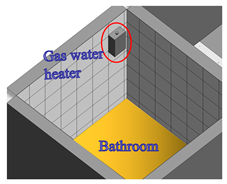 |
| SELECT ?a ?b ?ID1 ?ID2 ?a floor ?b floor WHERE{?a rdf:type ont:bathroom. ?b rdf:type ont:gas water heater. ?a ont:ID ?ID1. ?b ont:ID ?1D2 ?a ont:floor ?a floor. ?b ont:floor ?b floor. ?a ont:minx ?minx1. ?a ont:maxx ?maxx1. ?a ont:minx ?miny1. ?a ont:maxx ?maxy1. ?a ont:minx ?minz1. ?a ont:maxx ?maxz1. ?b ont:xo ?xo. ?b ont:yo ?yo. ?b ont:zo ?zo. Filter (?minx1 < ?xo < ?maxx1) Filter (?miny1 < ?yo < ?maxy1) Filter (?minz1 < ?zo < ?maxz1)} | ||
| JGJ/T67-2019 regulation for Design of Office Buildings 4.5.2: “The equipment room that generates noise or vibration should not be adjacent to office rooms and meeting rooms”. | Q4.1: | Set the equipment room adjacent to the meeting room: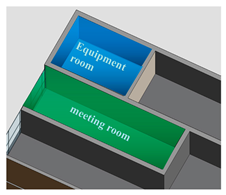 |
| SELECT ?a ?b ?ID1 ?ID2 ?a floor ?b floor WHERE{?a rdf:type ont:equipment room. ?b rdf:type ont:meeting room. ?a ont:ID ?ID1. ?b ont:ID ?1D2 ?a ont:floor ?a floor. ?b ont:floor ?b floor. ?a ont:minx ?minx1. ?b ont:minx ?minx2. ?a ont:miny ?miny1. ?b ont:miny ?miny2. ?a ont:maxx ?maxx1. ?b ont:maxx ?maxx2. ?a ont:maxy ?maxy1. ?b ont:maxy ?maxy2. filter (D1 < T1′ && D2 < T2)} | ||
| Q4.2: | ||
| SELECT ?a ?b ?ID1 ?ID2 ?a floor ?b floor WHERE {?a rdf:type ont:equipment room. ?b rdf:type ont:meeting room/office room. ?a ont:ID ?ID1. ?b ont:ID ?1D2 ?a ont:floor ?a floor. ?b ont:floor ?b floor. ?a ont:minx ?minx1. ?b ont:minx ?minx2. ?a ont:miny ?miny1. ?b ont:miny ?miny2. ?a ont:maxx ?maxx1. ?b ont:maxx ?maxx2. ?a ont:maxy ?maxy1. ?b ont:maxy ?maxy2. filter (D1 < T1 && D2 < T2′)} | ||
| GB50016-2014 regulation for Fire Prevention of Building Design 5.4.3:” Business Hall and exhibition hall shall not be set in the underground three floors or below”. | Q5: | Set up the business hall on the −3F: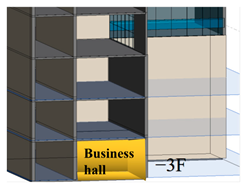 |
| SELECT ?a ?ID1 ?a floor WHERE {?a rdf:type ont:business hall. ?a ont:floor ?a floor. filter (?a floor < = −3)} | ||
| GB50016-2014 regulation for Fire Prevention in Building Design 6.1.5: “Doors, Windows, and holes shall not be opened on the firewall”. | Q6: | Set a hole in the firewall: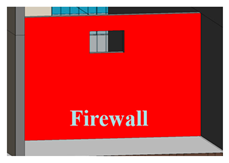 |
| SELECT ?a ?b ?ID1 ?ID2 ?a floor ?b floor WHERE {?a rdf:type ont:firewall. ?b rdf:type ont:hole/door/window. ?a ont:floor ?a floor. ?b ont:floor ?b floor. ?a ont:ID ?ID1. ?b ont:ID ?1D2 ?a inclusion ?b} |
| Checking Rules | Checking Results | ||||||
|---|---|---|---|---|---|---|---|
| a | b | a Floor | b Floor | ID1 | ID2 | ||
| Q1 | bedroom 2 | toilet 3 | First floor | Second floor | 2c_ndig5vF Mfxq2jZidAfO | 2c_ndig5vF Mfxq2jZidAiT | |
| Q2 | Q2.1 | wall 10 | First floor | 2c_ndig5vF Mfxq2jZidBJG | |||
| wall 6 | First floor | 2c_ndig5vF Mfxq2jZidBQ | |||||
| Q2.2 | wall 6 | First floor | 2c_ndig5vF Mfxq2jZidBQ_ | ||||
| Q3 | bathroom 1 | gas water heater 1 | Third floor | Third floor | 3U2xhP2_DDTOjTjy70bRDp | 3U2xhP2_DDTOjTjy70bRBn | |
| Q4 | Q4.1 | none | |||||
| Q4.2 | equipment room 2 | meeting room 3 | Fourth Floor | Fourth Floor | 1Z1gdTBtX60Qyk80qqrh3l | 1z1gdTBtX60Qyk80qqrh3g | |
| Q5 | business hall 3 | Negative Third floor | 3bLGP1Re9FWwmGxe3iHTpz | ||||
| Q6 | firewall 2 | hole 3 | Second floor | Second floor | 1Z1gdTBtX60Qyk80qqrh9t | 1Z1gdTBtX60Qyk80qqrhAD | |
Disclaimer/Publisher’s Note: The statements, opinions and data contained in all publications are solely those of the individual author(s) and contributor(s) and not of MDPI and/or the editor(s). MDPI and/or the editor(s) disclaim responsibility for any injury to people or property resulting from any ideas, methods, instructions or products referred to in the content. |
© 2023 by the authors. Licensee MDPI, Basel, Switzerland. This article is an open access article distributed under the terms and conditions of the Creative Commons Attribution (CC BY) license (https://creativecommons.org/licenses/by/4.0/).
Share and Cite
Zhao, X.; Huang, L.; Sun, Z.; Fan, X.; Zhang, M. Compliance Checking on Topological Spatial Relationships of Building Elements Based on Building Information Models and Ontology. Sustainability 2023, 15, 10901. https://doi.org/10.3390/su151410901
Zhao X, Huang L, Sun Z, Fan X, Zhang M. Compliance Checking on Topological Spatial Relationships of Building Elements Based on Building Information Models and Ontology. Sustainability. 2023; 15(14):10901. https://doi.org/10.3390/su151410901
Chicago/Turabian StyleZhao, Xuefeng, Lingli Huang, Zhe Sun, Xiongtao Fan, and Meng Zhang. 2023. "Compliance Checking on Topological Spatial Relationships of Building Elements Based on Building Information Models and Ontology" Sustainability 15, no. 14: 10901. https://doi.org/10.3390/su151410901
APA StyleZhao, X., Huang, L., Sun, Z., Fan, X., & Zhang, M. (2023). Compliance Checking on Topological Spatial Relationships of Building Elements Based on Building Information Models and Ontology. Sustainability, 15(14), 10901. https://doi.org/10.3390/su151410901






